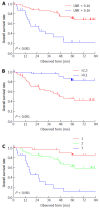Optimal treatment for Siewert type II and III adenocarcinoma of the esophagogastric junction: A retrospective cohort study with long-term follow-up
- PMID: 28487609
- PMCID: PMC5403751
- DOI: 10.3748/wjg.v23.i15.2723
Optimal treatment for Siewert type II and III adenocarcinoma of the esophagogastric junction: A retrospective cohort study with long-term follow-up
Abstract
Aim: To determine the optimal treatment strategy for Siewert type II and III adenocarcinoma of the esophagogastric junction.
Methods: We retrospectively reviewed the medical records of 83 patients with Siewert type II and III adenocarcinoma of the esophagogastric junction and calculated both an index of estimated benefit from lymph node dissection for each lymph node (LN) station and a lymph node ratio (LNR: ratio of number of positive lymph nodes to the total number of dissected lymph nodes). We used Cox proportional hazard models to clarify independent poor prognostic factors. The median duration of observation was 73 mo.
Results: Indices of estimated benefit from LN dissection were as follows, in descending order: lymph nodes (LN) along the lesser curvature, 26.5; right paracardial LN, 22.8; left paracardial LN, 11.6; LN along the left gastric artery, 10.6. The 5-year overall survival (OS) rate was 58%. Cox regression analysis revealed that vigorous venous invasion (v2, v3) (HR = 5.99; 95%CI: 1.71-24.90) and LNR of > 0.16 (HR = 4.29, 95%CI: 1.79-10.89) were independent poor prognostic factors for OS.
Conclusion: LN along the lesser curvature, right and left paracardial LN, and LN along the left gastric artery should be dissected in patients with Siewert type II or III adenocarcinoma of the esophagogastric junction. Patients with vigorous venous invasion and LNR of > 0.16 should be treated with aggressive adjuvant chemotherapy to improve survival outcomes.
Keywords: Adenocarcinoma of the esophagogastric junction; Lymph node dissection; Lymph node ratio; Prognostic factor; Venous invasion.
Conflict of interest statement
Conflict-of-interest statement: No potential conflicts of interest relevant to this article were reported.
Figures
Similar articles
-
Priority of lymph node dissection for Siewert type II/III adenocarcinoma of the esophagogastric junction.Ann Surg Oncol. 2013 Dec;20(13):4252-9. doi: 10.1245/s10434-013-3036-0. Epub 2013 Aug 14. Ann Surg Oncol. 2013. PMID: 23943020
-
Clinical significance of lower perigastric lymph nodes dissection in Siewert type II/III adenocarcinoma of esophagogastric junction: a retrospective propensity score matched study.Langenbecks Arch Surg. 2022 May;407(3):985-998. doi: 10.1007/s00423-021-02380-w. Epub 2021 Nov 18. Langenbecks Arch Surg. 2022. PMID: 34792614
-
Lymph Node Ratio Is an Independent Prognostic Factor for Patients with Siewert Type II Adenocarcinoma of Esophagogastric Junction: Results from a 10-Year Follow-up Study.J Gastrointest Cancer. 2021 Sep;52(3):983-992. doi: 10.1007/s12029-020-00468-y. J Gastrointest Cancer. 2021. PMID: 32954465
-
Overview of multimodal therapy for adenocarcinoma of the esophagogastric junction.Gen Thorac Cardiovasc Surg. 2015 Oct;63(10):549-56. doi: 10.1007/s11748-015-0575-2. Epub 2015 Aug 1. Gen Thorac Cardiovasc Surg. 2015. PMID: 26232357 Review.
-
Surgical Treatment of Gastroesophageal Junction Cancer.J Gastric Cancer. 2018 Sep;18(3):209-217. doi: 10.5230/jgc.2018.18.e28. Epub 2018 Sep 7. J Gastric Cancer. 2018. PMID: 30275998 Free PMC article. Review.
Cited by
-
Total laparoscopic transabdominal-transdiaphragmatic approach for treating Siewert II tumors: a prospective analysis of a case series.World J Surg Oncol. 2021 Jan 23;19(1):26. doi: 10.1186/s12957-021-02136-2. World J Surg Oncol. 2021. PMID: 33485350 Free PMC article.
-
Subclassification scheme for adenocarcinomas of the esophagogastric junction and prognostic analysis based on clinicopathological features.World J Gastrointest Oncol. 2025 Apr 15;17(4):103455. doi: 10.4251/wjgo.v17.i4.103455. World J Gastrointest Oncol. 2025. PMID: 40235906 Free PMC article.
-
Comparison of short-term outcomes following minimally invasive versus open Sweet esophagectomy for Siewert type II adenocarcinoma of the esophagogastric junction.Thorac Cancer. 2020 Jun;11(6):1487-1494. doi: 10.1111/1759-7714.13415. Epub 2020 Apr 1. Thorac Cancer. 2020. PMID: 32239662 Free PMC article.
-
Should Pyloric Lymph Nodes Be Dissected for Siewert Type II and III Adenocarcinoma of the Esophagogastric Junctions: Experience from a High-Volume Center in China.J Gastrointest Surg. 2019 Feb;23(2):256-263. doi: 10.1007/s11605-018-3935-2. Epub 2018 Oct 17. J Gastrointest Surg. 2019. PMID: 30334176
-
Can proximal Gastrectomy Be Justified for Advanced Adenocarcinoma of the Esophagogastric Junction?J Gastric Cancer. 2018 Dec;18(4):339-347. doi: 10.5230/jgc.2018.18.e33. Epub 2018 Nov 8. J Gastric Cancer. 2018. PMID: 30607297 Free PMC article.
References
-
- Devesa SS, Blot WJ, Fraumeni JF. Changing patterns in the incidence of esophageal and gastric carcinoma in the United States. Cancer. 1998;83:2049–2053. - PubMed
-
- Pohl H, Welch HG. The role of overdiagnosis and reclassification in the marked increase of esophageal adenocarcinoma incidence. J Natl Cancer Inst. 2005;97:142–146. - PubMed
-
- Kusano C, Gotoda T, Khor CJ, Katai H, Kato H, Taniguchi H, Shimoda T. Changing trends in the proportion of adenocarcinoma of the esophagogastric junction in a large tertiary referral center in Japan. J Gastroenterol Hepatol. 2008;23:1662–1665. - PubMed
-
- Blaser MJ, Saito D. Trends in reported adenocarcinomas of the oesophagus and gastric cardia in Japan. Eur J Gastroenterol Hepatol. 2002;14:107–113. - PubMed
MeSH terms
LinkOut - more resources
Full Text Sources
Other Literature Sources



